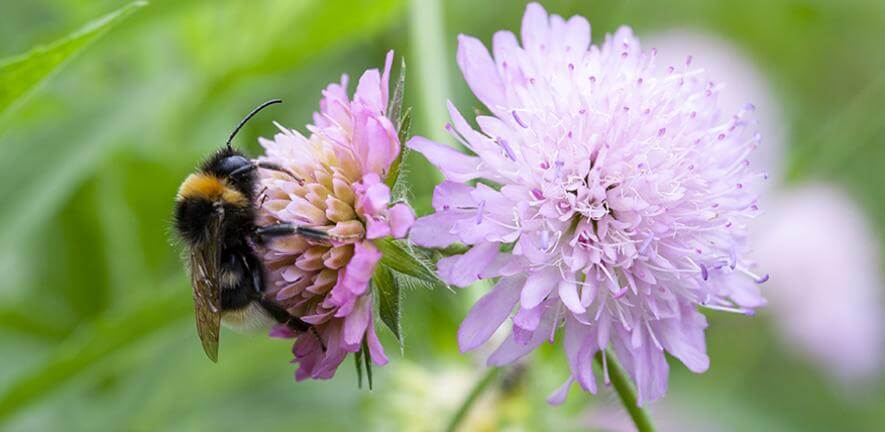Research has found that bumblebees make foraging choices to collect the most sugar from flowers in the shortest time – even if that means using more energy in the process – to provide an immediate energy boost for the colony.
A new study investigating nectar drinking in one of the most common bumblebees in the UK, Bombus terrestris, has found that when foraging they maximise the amount of nectar sugar they take back to the colony each minute.
To make their choices, the bumblebees trade off the time they spend collecting nectar with the energy content of that nectar. This means they will forage to collect nectar that’s hard to access – but only if the sugar content of that nectar makes it worth doing so.
This big-and-fast approach contrasts with honeybee foraging: honeybees make their decisions by optimising their individual energy expenditure for any nectar they collect. This more measured approach should prolong the honeybee’s working life.
“As they forage, bumblebees are making decisions about which nectar sources will give the greatest immediate energetic return, rather than optimising the energy efficiency of their foraging,” said Dr Jonathan Pattrick, joint first author of the report, who started the research while in the University of Cambridge’s Department of Plant Sciences.
Pattrick, now based at the University of Oxford, added: “Our results allow us to make predictions about the sorts of flowers the bumblebees are likely to visit, which could inform the choice of which flowers to plant in field margins to support these important pollinators. It’s also relevant to crop breeders who want to make varieties that are ‘better’ for bumblebees.”
The results are published today in the journal iScience.
Over six months the researchers made 60,000 behavioural observations of the bumblebees, allowing them to precisely estimate bumblebee foraging energetics. It was painstaking work: each bumblebee in the study was watched for up to eight hours a day without a break.
The team used vertically and horizontally oriented artificial flowers, with surfaces that were slippery and difficult for the bumblebees to grip.
A custom computer program allowed the team to measure the split-second timing as the bumblebees flew between the artificial flowers and foraged from them. This meant the team could track how much energy the bumblebees spent flying as well as how much they collected when drinking, and identify how the bumblebees decided whether to spend extra time and energy collecting high-sugar nectar from slippery flowers, or take the easier option of collecting lower-sugar nectar from flowers they could land on.
“It’s amazing that even with a brain smaller than a sesame seed, bumblebees can make such complex decisions,” said Dr Hamish Symington in the University of Cambridge’s Department of Plant Sciences and joint first author of the report.
He added: “It’s clear that bumblebee foraging isn’t based on a simple idea that ‘the more sugar there is in nectar, the better’ – it’s much more subtle than that. And it highlights that there’s still so much to learn about insect behaviour.”
Individual bumblebees were given one of three tests. In the first test, the nectar on both vertical and horizontal artificial flowers had the same amount of sugar, and the bumblebees made the obvious choice to forage from the horizontal flowers, rather than spend extra time and energy hovering at the vertical ones. In the second test, the nectar on the vertical flowers was much more sugary than the nectar on the horizontal flowers, and the bumblebees chose to drink almost exclusively from the vertical flowers.
In the third test, the vertical flowers offered nectar which was only slightly more sugary than the horizontal flowers. This created a situation in which the bumblebees had to make a trade-off between the time and energy they spent foraging and the energy in the nectar they were drinking – and they switched to feeding from the horizontal flowers.
The results show that bumblebees can choose to spend additional time and energy foraging from hard-to-access nectar sources – but only if the reward is worth it.
Bumblebees drink nectar from flowers, then offload it in their nest – by regurgitation – for use by other bumblebees in the nest. Unlike honeybees, bumblebees only store a small amount of nectar in the nest, so they need to make the most of every opportunity to forage.


